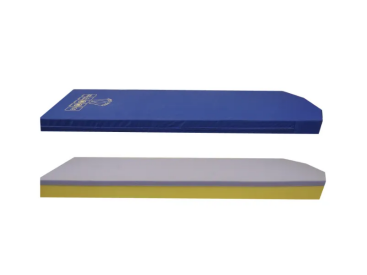How Ambulance Stretcher Mattresses Reduce Pressure Injuries
Pressure injuries, often called bedsores, are a critical risk for patients during ambulance transport, where movement is restricted and medical conditions may already weaken the skin. Ambulance stretcher mattress, vacuum mattress ambulance systems, and specialized stretcher mattress designs play a vital role in preventing these injuries by distributing pressure, supporting circulation, and adapting to the patient’s body. Beijing Suodina Trading Co., Ltd., a leading high-tech enterprise in foam manufacturing, contributes to this effort with their expertise in producing high-resilience and specialty foams. Their custom mattress factory crafts medical-grade mattresses, including those suitable for ambulance use, ensuring both comfort and protective support. These mattresses are engineered to address the unique challenges of pre-hospital care, where every bump and turn can increase pressure on vulnerable areas like the hips, heels, and shoulders.

Pressure Distribution in Ambulance Stretcher Mattress
- Conforming to Body Shape: A quality ambulance stretcher mattress uses viscoelastic or high-resilience foam that molds to the patient’s contours. This conformity ensures weight is spread evenly across the surface, reducing concentrated pressure on bony prominences—areas most at risk for pressure injuries. Unlike rigid surfaces, which create pressure points, these mattresses act like a gentle cradle.
- Variable Density Layers: Many stretcher mattressmodels feature layered foam with varying densities. Softer layers cushion sensitive areas, while firmer layers provide structural support. This combination balances comfort with stability, ensuring the mattress doesn’t sag excessively during transport and maintains consistent pressure distribution.
- Airflow Enhancement: Some ambulance stretcher mattressdesigns include channels or perforations that promote air circulation. This not only keeps the patient cool but also reduces moisture buildup—moisture weakens skin, making it more susceptible to breakdown. Improved airflow is especially crucial during long transports in hot or humid conditions.
Vacuum Mattress Ambulance Systems for Immobilization and Pressure Relief
- Custom Molded Support: A vacuum mattress ambulanceworks by removing air from a sealed mattress filled with small foam beads, causing it to harden into an exact mold of the patient’s body. This personalized fit immobilizes injuries (like fractures) while distributing pressure uniformly, eliminating gaps that could lead to pressure points.
- Shock Absorption: During ambulance rides, sudden stops or rough terrain can jostle patients, increasing pressure on specific areas. Vacuum mattress ambulancesystems absorb these shocks, maintaining consistent contact between the patient and the mattress. This stability reduces the micro-movements that rub against the skin, a common contributor to pressure injuries.
- Versatility for Different Patients: Whether the patient is a child, an adult, or someone with a larger frame, vacuum mattress ambulancesystems adapt to their size and shape. This versatility ensures that even patients with unique body types receive optimal pressure relief, a key advantage over one-size-fits-all stretcher mattress
Key Features of Stretcher Mattress Designs for Pressure Injury Prevention
|
Feature |
How It Reduces Pressure Injuries |
Example in Ambulance Mattresses |
|
Anti-Shear Surfaces |
Minimizes friction between skin and mattress during movement |
Smooth, low-friction covers on ambulance stretcher mattress |
|
Waterproof and Breathable |
Prevents moisture buildup while allowing air flow |
Vinyl-free covers that repel fluids but let heat escape |
|
Lightweight Construction |
Eases handling, ensuring mattress stays properly positioned |
Foam-based stretcher mattress that’s easy to adjust |
|
Edge Support |
Reduces pressure when patient shifts toward the stretcher edge |
Reinforced perimeter in vacuum mattress ambulance systems |
These features work together to create a protective barrier against pressure injuries, even during the most challenging transports.
Maintenance and Care of Ambulance Stretcher Mattress
- Regular Cleaning: After each use, clean the ambulance stretcher mattresswith hospital-grade disinfectants to remove pathogens and bodily fluids. Pay special attention to seams and crevices, where dirt and moisture can hide. For vacuum mattress ambulance systems, wipe the surface and ensure the valve is clean to maintain proper vacuum function.
- Inspection for Wear: Check the stretcher mattressfor tears, sagging, or compressed areas. Foam that no longer rebounds to its original shape won’t distribute pressure effectively, increasing injury risk. Replace worn mattresses promptly—Beijing Suodina’s durable foam designs are built to withstand frequent use but still require regular checks.
- Proper Storage: Store ambulance stretcher mattressin a cool, dry place when not in use. Avoid folding or stacking heavy objects on them, as this can damage the foam structure. For vacuum mattress ambulance systems, release the vacuum and store flat to prevent permanent creases.
Ambulance Stretcher Mattress FAQS
How Often Should an Ambulance Stretcher Mattress Be Replaced?
An ambulance stretcher mattress should be replaced every 3–5 years, depending on usage. Signs of wear like persistent sagging, tears, or reduced foam resilience mean it’s no longer effective at preventing pressure injuries and should be swapped out.
Are Vacuum Mattress Ambulance Systems Better Than Foam Stretcher Mattress?
Vacuum mattress ambulance systems excel at immobilization and custom pressure distribution, making them ideal for trauma patients. Foam stretcher mattress models are better for general transport and longer rides, offering consistent comfort. Both reduce pressure injuries but serve different needs.
Can a Stretcher Mattress Prevent All Pressure Injuries?
While a quality stretcher mattress significantly reduces risk, it can’t prevent all pressure injuries—factors like patient mobility, skin condition, and transport duration also play a role. Combining the mattress with regular repositioning (when possible) offers the best protection.
What Makes a Stretcher Mattress Suitable for Pediatric Patients?
Pediatric stretcher mattress models are smaller, with softer foam to match children’s lighter weight. They often have anti-slip surfaces to keep young patients secure, reducing movement that could cause friction and pressure points.
Where Can I Find High-Quality Ambulance Stretcher Mattress Options?
Beijing Suodina Trading Co., Ltd. offers medical-grade ambulance stretcher mattress solutions, crafted with their expertise in high-resilience and specialty foams. Their custom designs ensure optimal pressure relief and durability for pre-hospital care. Visit their website to explore their range of stretcher mattresses and other medical foam products.
-
The Truth About "Orthopedic" Mattresses for Sore Back PainBalitaAug.23,2025
-
Space-saving Benefits of a Single Mattress CubeBalitaAug.23,2025
-
Eco-friendly Advantages of a Silicon MattressBalitaAug.23,2025
-
How to Fix Sagging in a Special MattressBalitaAug.23,2025
-
Best Cleaning Practices for a Hospital Mattress DoubleBalitaAug.22,2025
-
Mattresses Designed for Back Pain ReliefBalitaAug.08,2025
-
Innovative Wave Mattresses for Ultimate ComfortBalitaAug.08,2025

